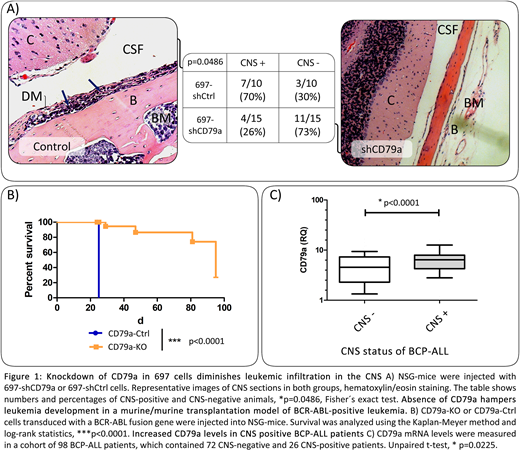Abstract

Despite the advances in the treatment of pediatric B-cell precursor acute lymphoblastic leukemia (BCP-ALL), infiltration of the central nervous system (CNS) remains a clinical challenge. Certain cytogenetic subtypes such as E2A-PBX1-and BCR-ABL-positive BCP-ALL confer a higher risk for CNS involvement initially and for CNS relapse. Novel strategies to predict CNS and to eradicate leukemic cells from the CNS are subjects of ongoing research.
In order to identify targets with diagnostic and therapeutic relevance, comparative RNA-sequencing was performed with patient derived xenograft (PDX) blasts from 5 E2A-PBX1-positive patients, recovered from the bone marrow (BM) and from the CNS of NOD.Cg-Prkdcscid Il2rgtm1Wjl/SzJ (NSG) mice. Differential gene expression analysis revealed the upregulation of various genes of the pre-B cell receptor complex, particularly the signaling component CD79a (Igα) in blasts recovered from the CNS as compared to blasts from the BM. We then investigated the impact of CD79a on CNS infiltration in vivo and in patients. CD79a was downregulated by short-hairpin RNA (shRNA) mediated knockdown in the E2A-PBX1 positive cell line 697. Proliferation rates of 697-shCD79a cells and control-transfected 697 cells (697-shCtrl) in vitro were similar. Furthermore, NSG mice injected with 697-shCD79a cells showed comparable survival times, as well as similar blast infiltration in spleen and BM as animals injected with 697-shCtrl cells. However, downregulation of CD79a led to a significantly lower number of CNS-positive mice (4/15, 26%) as compared to control animals (7/10, 70%) (p=0.0486, Figure A). This indicates that CD79a is not critically involved in proliferation and peripheral engraftment, but in CNS infiltration of E2A-PBX1 positive 697 cells in vivo.
To test if CD79a also affects CNS involvement in BCR-ABL-positive leukemia, a murine/murine transplantation model was used. B-cells isolated from CD79a-knockout (CD79a-KO) or wildtype mice (CD79a-Ctrl) were stably transfected with a BCR-ABL fusion gene and cultured independent of cytokines, thereby inducing malignant transformation. Both cell lines were subsequently injected into recipient NSG mice (n=8/group) and leukemic development was followed. The experiment was terminated when all control mice had developed leukemic symptoms and mice were analyzed for leukemic engraftment. A further CD79a-KO group was included for survival analysis. Median spleen volume as a surrogate of leukemic infiltration was significantly lower in mice injected with CD79a-KO as compared to CD79a-Ctrl cells (0.35 cm³ vs. 0.06 cm³; p=0.0001). Median blast percentages in spleens and BM were also markedly reduced (75.3% vs. 5.8%; p=0.0001 and 61.0% vs. 4.5%; p=0.0001, respectively). Importantly, none of the animals in the CD79a-KO group showed blasts in the CNS as assessed by histology whereas blasts were present in all of the animals in the CD79a-Ctrl group. Finally and most importantly, NSG-mice injected with CD79a-KO cells showed a highly significant prolongation in median survival as compared to mice with CD79a-Ctrl cells (29 days vs. 95 days; p=0.0001, Figure B). Altogether, these data suggest that in a model of BCR-ABL-positive leukemia, absence of CD79a impacts the engraftment of blasts in vivo, in the CNS and other leukemic niches.
To further validate our findings in patient material, we measured CD79a protein expression in PDX cells from an E2A-PBX1- and a BCR-ABL-positive patient serially transplanted into NSG mice for three passages. For both entities and in all passages, CNS blasts showed a higher CD79a expression than blasts isolated from the bone marrow. In order to assess if CD79a can be used as a marker to predict CNS involvement in patients, CD79a mRNA levels were measured in a selected cohort of 98 pediatric BCP-ALL patients, which contained 26 CNS-positive patients matched to 72 CNS-negative patients. CNS-positive patients showed significantly higher mRNA levels of CD79a than CNS-negative patients (p=0.0225, unpaired t-test, Figure C) suggesting that CD79a may be of value as a potential diagnostic marker for initial CNS involvement in BCP-ALL.
Our results indicate a role of CD79a in proliferation and CNS infiltration of BCP-ALL blasts in experimental settings and patients. We intend to prospectively evaluate CD79a as a prognostic marker, which may also be a therapeutic target in CNS-positive BCP-ALL.
No relevant conflicts of interest to declare.
Author notes
Asterisk with author names denotes non-ASH members.

This icon denotes a clinically relevant abstract


This feature is available to Subscribers Only
Sign In or Create an Account Close Modal